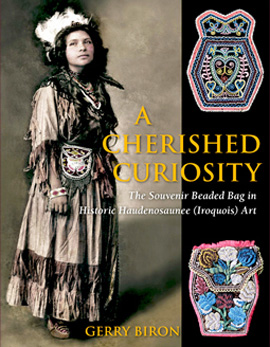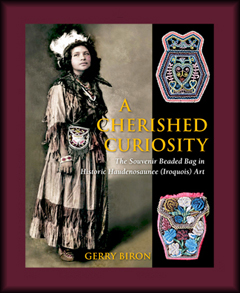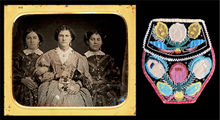 In the early 1800s, Native women of northeastern North America created a new art form: delicate, intricately beaded hats, purses and other whimsical objects. Sometimes referred to as “tourist" or "souvenir" beadwork, it played a crucial role in the subsistence of many Indian families during the nineteenth century. Native beadworkers came from diverse cultures and regions – the Haudenosaunee (Iroquois) of New York State and Canada and the Wabanaki from northern New England and the Maritime Provinces of Eastern Canada. Gifted with a refined sense of design, and sharing a passion for beadworking, they executed a profusion of bright, bold mosaics that included floral, figural, geometric, double-curve and sun symbol motifs. In addition to exploring the historical development of beadwork as an art form and as a subsistence practice for Native women, the “Made of Thunder” exhibit looked at beadworking within the context of art, fashion and the tourist economy of the nineteenth century.
In the early 1800s, Native women of northeastern North America created a new art form: delicate, intricately beaded hats, purses and other whimsical objects. Sometimes referred to as “tourist" or "souvenir" beadwork, it played a crucial role in the subsistence of many Indian families during the nineteenth century. Native beadworkers came from diverse cultures and regions – the Haudenosaunee (Iroquois) of New York State and Canada and the Wabanaki from northern New England and the Maritime Provinces of Eastern Canada. Gifted with a refined sense of design, and sharing a passion for beadworking, they executed a profusion of bright, bold mosaics that included floral, figural, geometric, double-curve and sun symbol motifs. In addition to exploring the historical development of beadwork as an art form and as a subsistence practice for Native women, the “Made of Thunder” exhibit looked at beadworking within the context of art, fashion and the tourist economy of the nineteenth century.
The first Europeans to set their sights on the New World were confronted with a people whose traditions and way of life were so different that, in retrospect, it was almost inevitable that their cultures would clash. From the time of first contact, and largely through the work of well meaning missionaries, a slow process of acculturation began to undermine the spiritual foundations of the Northeast woodland people. Conflicts from King Philip's War to the American Revolution facilitated the work of the missions, destroying not only the Indians' ancestral ties to the land, but their economic base as well, forever altering the lives and arts of these indigenous people.
The end of the Revolutionary War saw the beginning of two other revolutions that would also impact the lives and arts of the tribes from the Northeast. The first, tourism, was taking root as early as the 18th century. Americans, Canadians and Europeans too, intrigued by reports of picturesque spots such as Niagara Falls, the natural springs of Saratoga, the beauty and natural setting of Lake George and the coastal resort areas from Nova Scotia to New Jersey, were traveling to see these sights firsthand. Meanwhile, a second revolution was taking place in the fashion world of Paris. The preceding era's voluminous skirts evolved into a new thin and sheer style of women's dress. The revealing styles of the early nineteenth century made it more difficult to conceal pockets under a dress so this gave rise to the handbag as a major fashion accessory. A new bag had come into vogue, the stylish beaded reticule. It could be worn outside the skirt, and quickly became an essential article of women's attire.
Indian women, wisely assessing the needs and ideas of the encroaching white population, found subsistence in increasingly difficult times by adapting their traditional skills, and by selling and trading their arts and crafts to suit the emerging tourist markets. This early material has a spiritual quality about it that is akin to fine art. On the surface, these pieces were the canvas upon which an Indian artist displayed her technical skills and artistic vision. But below the surface, the power inherent in a beautiful object was a central feature of life. Festive dress was a language through which many an artist expressed her deepest beliefs about the universe. We may never know the full extent of their meanings, but imbedded within the designs are stories of a people told in symbols and motifs that spoke of a sacred relationship to the natural world. Many such stories are lost now, but the art survives as a legacy testifying to the inventiveness and sense of beauty of a marginalized people.
Made of Thunder, Made of Glass: American Indian Beadwork of the Northeast
By Gerry Biron
Paperback, 50 pp, 44 color plates and 26 black & white images - over 100 northeast woodland beaded bags and hats displayed in full color plus a dozen rare 19th century photographs of people wearing Iroquois beaded bags and hats. The book contains a 17 page essay detailing the influence of tourism and fashion on the production of early 19th century “Souvenir Beadwork” at Niagara Falls. An essential guide in the identification of styles and for dating 19th century northeast woodland beadwork, with an emphasis on beaded bags. This is the catalog for exhibit by the same name which was on display at the Abbe Museum in Bar Harbor, Maine, in 2006, the Memorial Hall Museum in Deerfield, Massachusetts, in 2007, the Mt. Kearsarge Museum in Warner, New Hampshire, in 2008 and the Institute for American Indian Studies in Washington, Connecticut, in 2009.
$24 - includes first class postal shipping in the USA. Email for postal rates outside the USA as they are slightly more.
Feature Articles
Gerry has written three feature articles about historic Northeast Woodland beadwork:
Haudenosaunee (Iroquois) Participation in 19th Century Medicine Shows
In: Whispering Wind magazine – American Indian: Past and Present Vol. 42, No. 1, 2013
A Cherished Curiosity: The Niagara Floral-style Beaded Bag in the Victorian Era
In: American Indian Art Magazine – Fall, 2010
Made of Thunder, Made of Glass: Niagara Falls and its Influence on the Production of American Indian Beadwork in the Northeast.
In: Whispering Wind Magazine – American Indian: Past and Present Vol. 36. No. 4, 2007



